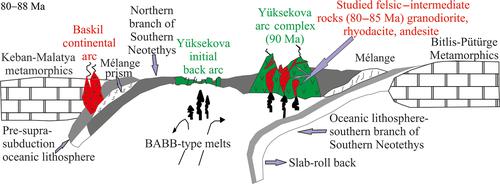当前位置:
X-MOL 学术
›
Acta Geol. Sinica Engl. Ed.
›
论文详情
Our official English website, www.x-mol.net, welcomes your feedback! (Note: you will need to create a separate account there.)
Geochemistry and Zircon U-Pb Dates of Felsic-Intermediate Members of the Late Cretaceous Yüksekova Arc Basin: Constraints on the Evolution of the Bitlis–Zagros Branch of Neotethys (Elazığ, E Turkey)
Acta Geologica Sinica-English Edition ( IF 3.3 ) Pub Date : 2021-04-01 , DOI: 10.1111/1755-6724.14694 Melek URAL 1 , Kaan SAYIT 2 , Osman Ersin KORALAY 3 , Mehmet Cemal GONCUOGLU 2
Acta Geologica Sinica-English Edition ( IF 3.3 ) Pub Date : 2021-04-01 , DOI: 10.1111/1755-6724.14694 Melek URAL 1 , Kaan SAYIT 2 , Osman Ersin KORALAY 3 , Mehmet Cemal GONCUOGLU 2
Affiliation

|
During the Late Cretaceous in the Eastern Mediterranean, the northern branch of the southern Neotethys was closed by multiple northward subductions. Of these, the most northerly located subduction created the Baskil continental arc at around 82–84 Ma. The more southerly and intra-oceanic subduction, on the other hand, produced an arc-basin system, the Yüksekova Complex, as early as the late Cenomanian–early Turonian. The abundant and relatively well-studied basaltic rocks of this complex were intruded by dykes, sills and small stocks of felsic–intermediate rocks, not previously studied in detail. The intrusives collected from five different localities in the Elazığ region of eastern Turkey are all subalkaline, with low Nb/Y values. Most of them have been chemically classified as rhyodacites/dacites, whereas a small number appear to be andesites. In normal mid-ocean-ridge basalt (N-MORB)-normalised plots, the intrusives are characterised by relative enrichments in Th and La over Nb, Zr, Hf, Ti and high field strength elements (HREEs), indicating their derivation from a subduction-modified source. While their relatively high, positive εNd(i) values (+6.4 and +7.2) might suggest a depleted mantle source for their ultimate origin, somewhat radiogenic Pb values indicate a sedimentary contribution to the source of the rocks. The overall geochemical characteristics indicate their generation in an oceanic arc setting. The zircon U-Pb Laser ablation-inductively coupled plasma-mass spectrometry (LA-ICP-MS) data obtained from five felsic-intermediate rock samples yielded intrusion dates of 80–88 Ma. This suggests that the Elazığ oceanic arc-related intrusives are slightly younger than those of the Yüksekova arc-basin system, but coeval with the Baskil continental arc. However, the felsic–intermediate intrusives show different geochemical characteristics (oceanic arc-type, with a lack of crustal contamination) to those of the Baskil continental arc. This indicates that these two igneous systems are unrelated and likely developed in different tectonic settings. This, in turn, supports a geodynamic model in which the northern strand of the southern Neotethys was consumed by multiple northward subductions.
中文翻译:

晚白垩世 Yüksekova 弧盆地长英质中段的地球化学和锆石 U-Pb 日期:对新特提斯的 Bitlis-Zagros 分支演化的约束(Elazığ,E 土耳其)
在东地中海晚白垩世,新特提斯南部的北支被多次向北俯冲关闭。其中,位于最北端的俯冲在 82-84 Ma 左右形成了 Baskil 大陆弧。另一方面,更偏南和大洋内的俯冲早在赛诺曼阶晚期 - 土伦阶早期就产生了一个弧盆系统,Yüksekova 复合体。该复合体中丰富且研究相对充分的玄武岩被岩脉、窗台和少量长英质-中质岩石侵入,以前没有详细研究过。从土耳其东部 Elazığ 地区五个不同地点收集的侵入物都是亚碱性的,Nb/Y 值较低。它们中的大多数在化学上被归类为流纹英安岩/英安岩,而少数似乎是安山岩。在正常的洋中脊玄武岩 (N-MORB) 归一化图中,侵入物的特征是 Th 和 La 相对 Nb、Zr、Hf、Ti 和高场强元素 (HREE) 的富集,表明它们来自于俯冲改性源。虽然它们相对较高,正 ε钕( i) 值 (+6.4 和 +7.2) 可能表明它们最终起源的地幔源已耗尽,有些放射成因的 Pb 值表明沉积物对岩石源的贡献。整体地球化学特征表明它们是在大洋弧环境中产生的。锆石 U-Pb 激光烧蚀电感耦合等离子体质谱 (LA-ICP-MS) 数据从五个长英质中质岩石样品获得,侵入日期为 80-88 Ma。这表明 Elazığ 大洋弧相关侵入体比 Yüksekova 弧盆系统的侵入体略年轻,但与 Baskil 大陆弧同时期。然而,长英质-中质侵入岩显示出与巴斯基尔大陆弧不同的地球化学特征(大洋弧型,无地壳污染)。这表明这两个火成岩系统是不相关的,很可能是在不同的构造环境中发展起来的。这反过来又支持了一个地球动力学模型,在该模型中,新特提斯南部的北部链被多次向北俯冲所消耗。
更新日期:2021-04-01
中文翻译:

晚白垩世 Yüksekova 弧盆地长英质中段的地球化学和锆石 U-Pb 日期:对新特提斯的 Bitlis-Zagros 分支演化的约束(Elazığ,E 土耳其)
在东地中海晚白垩世,新特提斯南部的北支被多次向北俯冲关闭。其中,位于最北端的俯冲在 82-84 Ma 左右形成了 Baskil 大陆弧。另一方面,更偏南和大洋内的俯冲早在赛诺曼阶晚期 - 土伦阶早期就产生了一个弧盆系统,Yüksekova 复合体。该复合体中丰富且研究相对充分的玄武岩被岩脉、窗台和少量长英质-中质岩石侵入,以前没有详细研究过。从土耳其东部 Elazığ 地区五个不同地点收集的侵入物都是亚碱性的,Nb/Y 值较低。它们中的大多数在化学上被归类为流纹英安岩/英安岩,而少数似乎是安山岩。在正常的洋中脊玄武岩 (N-MORB) 归一化图中,侵入物的特征是 Th 和 La 相对 Nb、Zr、Hf、Ti 和高场强元素 (HREE) 的富集,表明它们来自于俯冲改性源。虽然它们相对较高,正 ε钕( i) 值 (+6.4 和 +7.2) 可能表明它们最终起源的地幔源已耗尽,有些放射成因的 Pb 值表明沉积物对岩石源的贡献。整体地球化学特征表明它们是在大洋弧环境中产生的。锆石 U-Pb 激光烧蚀电感耦合等离子体质谱 (LA-ICP-MS) 数据从五个长英质中质岩石样品获得,侵入日期为 80-88 Ma。这表明 Elazığ 大洋弧相关侵入体比 Yüksekova 弧盆系统的侵入体略年轻,但与 Baskil 大陆弧同时期。然而,长英质-中质侵入岩显示出与巴斯基尔大陆弧不同的地球化学特征(大洋弧型,无地壳污染)。这表明这两个火成岩系统是不相关的,很可能是在不同的构造环境中发展起来的。这反过来又支持了一个地球动力学模型,在该模型中,新特提斯南部的北部链被多次向北俯冲所消耗。



























 京公网安备 11010802027423号
京公网安备 11010802027423号